The second day’s tour was beyond the main complex, starting from the Bantey Srei temple, and a good 32 kilometers away from Siem Reap town. The roads were not in great shape and the journey takes a bit longer because of this plus we had torrential rain coming down literally in buckets. Bantey Srei is located at the foot of the Kulen Mountains. This site is rather small but contains many rich and intricate stone carvings representing various stories in Hinduism. This temple was constructed by a Brahmin priest called Yajnavaraha who later reportedly became the guru of King Jayavarman V. He must have indeed been an influential chap to have had the kind of resources that are required for a sculpture rich site such as this one.
 Pink Sandstone doorway carved with the Narasimha relief at Bantey Srei
Pink Sandstone doorway carved with the Narasimha relief at Bantey SreiBack to the subject of temples and Preah Kahn was next, built in the late 12th Century C.E. in the Bayon style by King Jayavarman VII and later additions by Jayavarman VIII. This is mainly Buddhist in nature and therefore you’d see a few Naga depictions common to Hindu and Buddhist sites and specifically stories centered on the life of the Buddha. This site was not just a temple but a Buddhist university with more than 1,000 teachers, according to the inscriptions found there. Later in the late 13th Century, this place reverted back to Hinduism and one can see giant 15 meter tall rock carvings of “Garuda” the mythical eagle that is known as the vehicle of Lord Vishnu. Garuda is seen clutching two serpents (his favorite food, of course!) and spreading his wings in delight. I saw a smirk on his beak, I swear it!
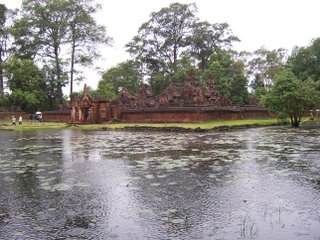 All Angkor temples and sites are surrounded by a moat and during the wet season, these are full
All Angkor temples and sites are surrounded by a moat and during the wet season, these are full A two story structure at Preah Khan
A two story structure at Preah Khan
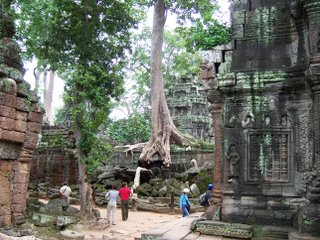 A photo that got here by mistake-from Ta Phorm Temple mentioned in the previous blog post
A photo that got here by mistake-from Ta Phorm Temple mentioned in the previous blog post
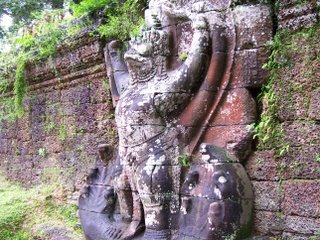 The Garuda, mythical bird and vehicle of Lord Vishnu clutching two snakes, see the glee on his face! This was at the outer wall of Preah Khan complex, mentioned above.
The Garuda, mythical bird and vehicle of Lord Vishnu clutching two snakes, see the glee on his face! This was at the outer wall of Preah Khan complex, mentioned above.
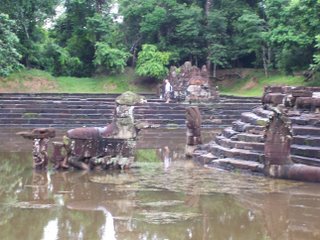 The Horse in the pond at Neak Pean
The Horse in the pond at Neak Pean
Neak Pean is unusual and it has a central square pond surrounded by square ponds on four sides. The small temple is in the middle of the pond. This place apparently used hydraulics to create a fountain of sorts. It started out as a Hindu concept and structure but changed to add Buddhist ideas and motifs in the temple. One can see a large stone flying horse (unfinished) in the central pond and when observed closely, one can see people hanging on to the horse, even at its tail. This is based on a Buddhist story where a Bodhisattva took the form of the horse called Balaha and rescued sea faring merchants from an Island that was ruled by an Ogress!
After finishing visiting all the sites, we went back to Siem Reap and wandered around town mainly around an area known as “Pub Street” where all foreigners hang out to have a drink and eat. Some of these “pubs” have live performances of local dances based again on Hindu Mythology and it’s good to see them. Some of these places offer free performances so long as you stick around and drink something. The local dances are commonly known as “Apsara” dances, named after the beautiful Apsara women that are thought to inhabit heaven! Apsara carvings dominatemany of the Angkor sites, in various dance positions.
 Another tree growing out of the temple at Ta Phrom complex mentioned in my last blog
Another tree growing out of the temple at Ta Phrom complex mentioned in my last blog

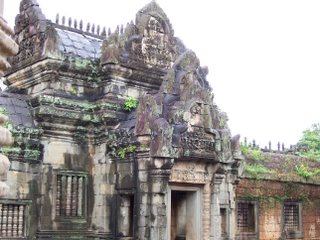
2 comments:
Great pictures and lovely description, captain! You are as good with photography as with aoroplane controls and with the pen too! Thanks a lot.
E.R. Ramachandran
23 Nov, 2006
You are welcome sir. Sorry about publishing your comment a day late, just returned from a trip. I'm going to work on the next episode on the cambodia trip and post it with more pictures this week (hopefully!). Thanks for your encouragement.
Post a Comment